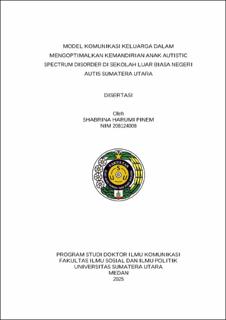Model Komunikasi Keluarga dalam Mengoptimalkan Kemandirian Anak Autistic Spectrum Disorder di Sekolah Luar Biasa Negeri Autis Sumatera Utara
Family Communication Models in Optimizing the Independence of Children with Autistic Spectrum Disorder at Sekolah Luar Biasa Negeri Autis Sumatera Utara

Date
2025Author
Pinem, Shabrina Harumi
Advisor(s)
Zulkarnain, Iskandar
Nurbani
Kurniawati, Dewi
Metadata
Show full item recordAbstract
This study focuses on family communication models in optimizing the independence of children with Autistic Spectrum Disorder (ASD) at Sekolah Luar Biasa Negeri Autis Sumatera Utara. Children with ASD experience complex neurobiological developmental disorders that affect their growth and daily life, including communication, learning, and relationships with others. The study aims to analyze the challenges faced by children with ASD in social interactions, explore communication messages exchanged between parents and children in daily life, and identify effective family communication strategies to enhance their independence. Ultimately, this research seeks to develop a suitable family communication model to optimize the independence of children with ASD at the school. This research employs a descriptive qualitative approach, with data collected through in-depth interviews, literature studies, and documentation. The study involved six informants, consisting of three primary informants and three additional informants. The data analysis follows the qualitative method proposed by Miles, Huberman, and Saldana, with source triangulation used to ensure data validity. The theoretical framework includes intrapersonal communication, interpersonal communication, family communication, cognitive dissonance theory, family communication pattern theory, and expectancy violation theory. The findings reveal that independence is a primary goal for children with ASD and their families. The family communication model is viewed from two complementary and crucialperspectives, requiring consistent collaboration between teachers and parents. From the teacher’s perspective, communication models include four aspects: Flexible Teaching, Participative Model, Interactive Teaching Model and Adaptive and Responsive Model. From the parent’s perspective, the models include Adaptive and Direct Model, Nonverbal Model, Simple Instruction Model, and Verbal Reduction
